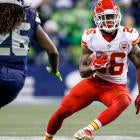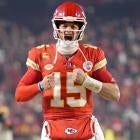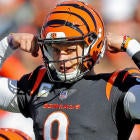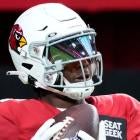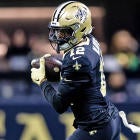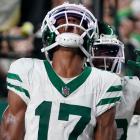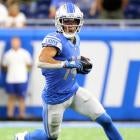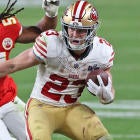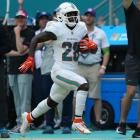Damien Williams' Fantasy Football Average Draft Position is on the rise as we march toward the start of the season, turning Williams into one of the most polarizing players we'll look at this summer.
Fortunately there's nothing polarizing about what team he'll play for. As the starting running back for the Chiefs, he's clearly in the right place at the right time -- and with the right playcaller.
Long-time head coach Andy Reid is living his best life at the helm of this Patrick Mahomes-led offense. The quarterback not only has a cannon for an arm but also happens to be accurate and mind-blowingly crafty. Additionally, he's got big targets and fast targets at his disposal, forcing defenses into a molar-grinding game of chicken over who and how they cover the field play after play. Safeties can't crowd the box, blitzes can be beaten, and zone coverages can be out-run -- or out-smarted.
It's a dream spot for any running back. Williams is simply the one first in line to benefit the most.
I spent time going over every play Williams was in on last season. Reid has unearthed a speedy runner who is just as good in the passing game as his stats suggest. He's also good about getting to the edge on outside runs while showing a knack for having good vision and change-of-direction ability when a running lane clogs.
| Damien Williams' last seven games | |
| Receiving averages (per game) | 5.0 targets, 4.3 rec., 33.3 yards |
| Receiving touchdowns | Four in seven games |
| 33 total catches | 7 for 10+ yards (21.2%), 20 for 5+ yards (60.6%) |
| 85 total carries | 14 for 10-plus yards (16.5%), 48 for 4-plus yards (56.5%) |
| Downs of < 3 yds | Converted 13 of 20 (65%) via run |
Williams leaves something to be desired in his physicality, but he's not shy about contact in the least. It's just that most of his success came when he bounced it outside or caught a pass. Inside running plays rarely led to long gains. And while he has the heart to pass block, he was rarely asked to do it, frequently running a route on passing plays.
The Chiefs worked around these minor deficiencies last year and they had an amazing rushing presence because of it. The hope is that those few shortcomings don't come back to unravel a potential monster season for Williams.
Competition
The Chiefs didn't waste much time in signing Carlos Hyde, grabbing him about 24 hours after his release from the Jaguars. He's practically the inverse of Williams. A strong, physical back without top-end speed and elusiveness. He also has far more experience in pass blocking.
Maybe this shocks you, maybe it doesn't, but this isn't the running back to fear taking over for Williams.
| Tale of the Tape | ||
| 2018 | Hyde | Williams |
| Rushing average | 3.3 | 5.1 |
| Receiving average | 1.0 | 7.0 |
| Runs of 10-plus yards | 15 | 14 |
| Downs of < 3 yards converted | 51.7% | 65% |
| PFF Yards after contact per attempt | 2.38 | 2.52 |
| PFF pass blocking efficiency | 87.5 | 96.4 |
| *Hyde played 13 games, Williams essentially played in 7 | ||
Given that he'll be nearly 29 years old when the season starts and just isn't the same kind of back he once was, Hyde has a lot to prove this summer to warrant a nice role on the Chiefs roster, much less relevance in Fantasy Football. He might do well with a big opportunity this season, but the only way it'll happen is because others on the depth chart fall off or get hurt.
Darwin Thompson was the Chiefs' sixth-round pick in April's draft. A muscular mini-Hulk at 5-foot-8, Thompson played only one year at Utah State after three years at Northeastern Oklahoma A&M but amassed nearly 1,400 total yards and 16 total touchdowns. He was a top-20 recruit out of high school, so the talent has been there all along.
| About Darwin Thompson | |
| Height | 5-8 |
| Weight | 198 |
| 40 time | 4.6 |
| Bench | 23 reps |
| SPARQ | 119.0 (74th) |
In many ways, Thompson is just like Williams. Both are fast, outside runners with good receiving skills. Both also lack physicality on inside runs. Reid compared Thompson to Charcandrick West this offseason, but the hope is Thompson will have better vision and won't see his skills erode as quickly as West's. He'd have to be completely unprepared in training camp to not make the Chiefs' final roster.
Because he's younger, faster and more versatile than Hyde, I believe Thompson is the one who would see a nice bump in playing time if Williams cannot get the job done. Hyde would play too, but Reid's offenses have long been predicated on fast running backs with good receiving skills. That's why Williams turned out to be such a good fit, and it should be why Thompson will be too.
All of this being said, I doubt Hyde nor Thompson will cut significantly into Williams' playing time. Williams should continue on a pace for roughly 50 snaps and 16 touches per game.
Offensive line
The Chiefs' tackle spots are pretty dependable -- Eric Fisher and Mitchell Schwartz are a nice tandem. But the interior line has some question marks. Ex-Browns tackle Cameron Erving is penciled in at left guard, Austin Reiter (another Browns castoff) is in line to man the middle and Laurent Duvernay-Tardif will administer blocks at right guard. The depth behind them is very inexperienced, so if anything happens to them, things could get really dicey.
This is where Williams' lack of power running comes into play. He'll be limited on power runs up the middle and behind his guards if he's not getting a powerful push from his interior line.
The good news is that Williams will be used a bunch on zone-scheme runs, which suits him better. Reid & Co. were seemingly aware of this last year and deployed Williams accordingly.
| Williams' regular-season runs | ||
| Scheme | Stats | Rush avg. |
| Zone | 38-203-3 | 5.3 |
| Power | 12-53-1 | 4.4 |
| * per Sports Info Solutions | ||
The extra wrinkle that works in the offensive line's favor is the scheme and talent in the Chiefs passing game. It's not a good plan to dare Mahomes to throw, which is why teams rarely lined up their safeties and linebackers close to the line of scrimmage. Tyreek Hill's potential absence is a factor, but as long as the Chiefs have some deep threat on the field, it'll be dangerous for defenses to crowd the line of scrimmage against the run. That helps the offensive line do its job, and that clearly helps Williams' outlook.
Availability and experience
Williams has missed a total of six games in five NFL seasons. That sounds nice, but he was more or less a special-teams player for most of his career. He hurt his shoulder the first time he was given a sizable portion of offensive reps in 2017 with Miami. Luckily, this is the only time he's suffered a significant injury -- he never suffered a serious injury in two seasons at Oklahoma, leaving in 2013 for violating team rules. We don't have enough information to call Williams an injury risk (beyond him playing running back, which in and of itself is an injury risk).
But we definitely have enough information to know Williams is inexperienced as an NFL lead back. The 82 carries and 30 catches he had in his final seven games is equal to about half of his previous 4.5 years of experience (136 carries, 88 receptions). It helps that Williams was the Sooners' main runner in 2012 and 2013, but that doesn't do anything to ease Fantasy managers' fears about how he'll do six years later.
This is the biggest risk in drafting Williams. We've seen countless running backs come out of nowhere to have a monster season or half-season, only to disappoint the following year. There's literally been at least one running back every year who's done it since 2008 (and many before).
| One-and-done | ||
| 2017: Dion Lewis | 2017: Alex Collins | 2016: Rob Kelley |
| 2016: Spencer Ware | 2015: Jeremy Langford | 2014: Justin Forsett |
| 2013: Zac Stacy | 2012: Mikel Leshoure | 2011: Roy Helu |
| 2010: Peyton Hillis | 2009: Jerome Harrison | 2008: Steve Slaton |
It doesn't mean Williams cannot do it, though. The likes of Devonta Freeman, Latavius Murray and Jeremy Hill all broke out mid-season and stuck. So too did Edgar Bennett, Dorsey Levens and Brian Westbrook -- all on teams where Reid was part of or leading the coaching staff. If you want to add unproven backs-turned-Week-1-starters to the list, LeSean McCoy and Kareem Hunt count as Reid disciples.
So if you're going to trust an inexperienced running back with a half-season of good play, might as well be one coached up by Reid. Jamey Eisenberg did a nice job referencing this when he came around on drafting Williams.
Worth his Fantasy ADP?
You already know Williams carries substantial upside -- we saw that last year. Is he worth the risk of being taken where his ADP is headed?
Because that ADP is getting pretty, pretty high.
On FantasyPros' consensus ADP, he's moved into 22nd overall in non-PPR and 28th overall in full PPR. On Fantasy Football Calculator he's even higher -- 20th overall in non-PPR and PPR. He's very much in the same neighborhood as Dalvin Cook and Leonard Fournette, two backs with better pedigrees but greater injury risks.
But the real eye-opener is in Fantasy Football Players Championship Best Ball ADP, which covers the draft averages for players taken in season-long, no-lineup-setting formats. Williams is trending into the high teens!
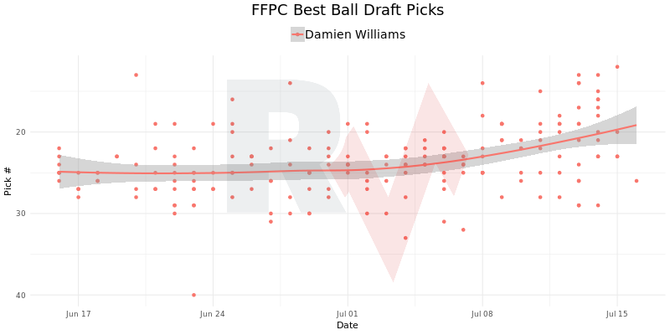
I can say with certainty that Williams in Round 3 is money. I've been getting him there in most of our analyst drafts this offseason and feeling great about it.
But when you put Williams in the mid-Round 2 range -- in the same space as stud tight ends George Kittle and Zach Ertz and the same space as Keenan Allen, T.Y. Hilton and Amari Cooper, it's not such a feel-good story. Williams would have to perform to nearly the same level he did last year to overtake these 90-catch, 1,200-yard, eight-score candidates. There's really little room for error here -- if Williams falters even a little bit, he's a bad pick in Round 2.
The only way I could see it making sense is if a massive running back run takes up the first 15 or so picks on Draft Day and you don't want to get shut out of the position. In this case, Williams could be an easy mid-Round 2 pick since someone at receiver or tight end would fall into your lap in Round 3. Paying attention to position scarcity during your draft is always a must.
But short of that, Williams cannot be taken that soon. The risk is just too high. Someone safer can be had with expectations that we've previously seen as being met.
Toward the tail end of Round 2 is much easier to digest since the pool of very good players in Round 3 figures to be large enough to account for Williams' risk. You could always chance it and go with a different player in Round 2 in hopes Williams slides to Round 3, a real possibility since those teams picking early in Round 1 might opt to double-down on pass-catchers in Rounds 2 and 3.
The Caveat
If you're going to draft Williams, you should solidify your investment and back him up with Darwin Thompson. Not Carlos Hyde.
That's the Chiefs duo to target. Williams and Thompson have the preferred pass-smart skill-set to make noise in today's NFL. They're in the best scheme possible, with the most threatening quarterback possible, running plays from one of the best offensive playcallers possible.
You'll be able to back up Williams with a 10th-round pick, a cheap price to pay. It's worth taking him there even if his ADP stays low, just to have this backfield locked up.
By drafting Williams and Thompson, you're also drafting Andy Reid. That's worked out well for Fantasy managers for the better part of the last decade.













